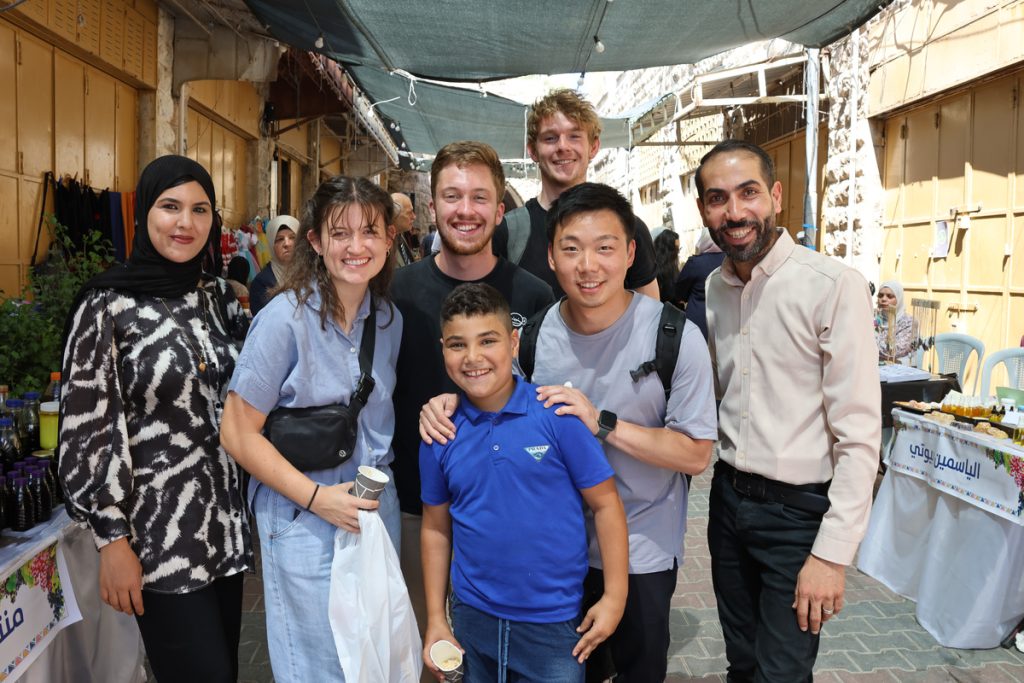Palestinian Arabic is one of the most widely spoken and culturally rich varieties of the Arabic language. As a branch of Levantine Arabic, it is used by millions of Palestinians across the West Bank, Gaza Strip, and within Israel, as well as in large diaspora communities around the world. This dialect reflects the Palestinian people’s historical, social, and political experiences. It has evolved over centuries through contact with other cultures and languages, including Hebrew, Turkish, English, and Aramaic.
Palestinian Arabic is more than just a means of communication—it carries identity, heritage, and resistance. While it shares many linguistic features with neighboring Levantine dialects such as Jordanian, Lebanese, and Syrian Arabic, it also maintains unique vocabulary, pronunciation, and expression characteristics. Despite the increasing dominance of Modern Standard Arabic (MSA) in education, media, and formal communication, Palestinian Arabic remains the primary language of daily life, storytelling, music, and interpersonal connection among Palestinians.
In the following sections, you’ll find essential facts about the dialect’s origins, structure, and usage, key differences from MSA and practical examples to help you recognize and learn the sounds and rhythms of Palestinian speech. Whether you’re a language learner, a traveler, or someone interested in the culture, understanding Palestinian Arabic is a gateway to deeper connections with Palestinian society and its diverse voices.
Table of Contents
Essential Facts About Palestinian Arabic
| Category | Details |
|---|---|
| Name | Palestinian Arabic (اللغة العربية الفلسطينية – al-Lugha al-‘Arabiyya al-Filastīniyya) |
| Also Known As | Palestinian Levantine, Palestinian Dialect |
| Language Family | Semitic → Central Semitic → Arabic → Levantine Arabic → Palestinian Arabic |
| Region Spoken | Palestine (West Bank, Gaza Strip, and Israel), Palestinian diaspora in the Middle East and worldwide |
| Number of Speakers | Over 8 million (including diaspora communities) |
| Status | Spoken in daily life, with MSA used for formal writing, education, and media |
| Relation to MSA | Shares core vocabulary and grammar; Palestinian Arabic is close to MSA, especially in formal contexts |
| Influences | Hebrew, Turkish, Aramaic, Greek, Latin, Persian, and Modern Hebrew due to historical and geographical factors |
| Written Form | Rarely written in daily use, MSA is employed for formal writing and education |
| Media Use | Understood across the Levantine region; partially understood in other Arab areas, with some regional variations in vocabulary and pronunciation |
| Mutual Intelligibility | Rarely written daily, MSA is employed for formal writing and education. |
Palestinian Arabic is a key dialect within Levantine Arabic, exhibiting close relations with other varieties spoken in neighboring regions like Jordanian and Lebanese Arabic. Despite its geographical and cultural diversity, Palestinian Arabic maintains a distinct identity shaped by its rich history and evolving interactions with other languages.
Who Speaks Palestinian Arabic?
Palestinian Arabic is spoken by the Palestinian population in Palestine (including the West Bank, Gaza Strip, and Israel) and by Palestinian communities in the diaspora, particularly in countries across the Middle East, such as Jordan, Lebanon, Syria, and Egypt, as well as in global diaspora communities, including the United States, Canada, and Europe. T
he dialect has absorbed influences from languages and cultures with which Palestinians have interacted throughout history, including Hebrew, Turkish, Greek, and Persian, as well as modern influences from English and French. Palestinian Arabic is widely understood throughout the Levant and is closely related to other Levantine dialects, particularly Jordanian, Syrian, and Lebanese Arabic. While Palestinian Arabic shares many features with these neighboring dialects, it maintains its own distinct vocabulary, pronunciation, and grammatical nuances.
Differences Between Palestinian Arabic and Modern Standard Arabic
As in many Arabic-speaking societies, Palestine operates within a system of diglossia, where two forms of Arabic coexist and serve different roles: Modern Standard Arabic (MSA) and Palestinian Arabic. MSA is the formal, standardized variety of the language used in official settings, such as government communication, education, news broadcasts, and religious discourse. It is the version of Arabic taught in schools and used in writing, public speeches, literature, and media across the Arab world.
In contrast, Palestinian Arabic is the everyday spoken language used by Palestinians in casual conversations, family life, social gatherings, and marketplaces. It is rich in local expressions, informal in tone, and shaped by historical influences from Hebrew, English, Turkish, and other regional dialects. Though rooted in the same language family as MSA, Palestinian Arabic has developed its own phonetic patterns, vocabulary, and grammatical shortcuts, such as simpler verb conjugations and word structures, which distinguish it clearly from formal Arabic.
Pronunciation and vocabulary mark some of the most noticeable differences between the two. For instance, the letter ق (qaf) is often pronounced as a glottal stop [ʔ] in Palestinian Arabic, especially in urban areas, while MSA retains the classical [q] sound. Words borrowed from other languages, as well as idioms and slang, are common in the spoken dialect but generally absent from formal MSA. While most Palestinians can switch fluidly between the two depending on context, learners of only one variety, particularly those focused solely on the spoken dialect, may find it challenging to fully understand or use the other, especially in formal or literary settings.
Linguistic Features of Palestinian Arabic
Palestinian Arabic shares its core structure with other Levantine dialects and Modern Standard Arabic (MSA), but it includes many unique vocabulary items and loanwords shaped by history and geography. These borrowings often come from languages like English, Turkish, Hebrew, and French. Some commonly used examples include:
- ʔōtōbīs = bus (origin: English/European)
- dōr = turn, as in “my turn” (origin: Hebrew)
- šanta = bag (origin: Turkish)
- ʔīsāb = account (shared with MSA but pronounced differently)
- kēš = cash (origin: English)
- bēt = house (shared with MSA but often shortened or used in compound forms like bēt il-ʕīle – family home)
Palestinian Arabic pronunciation features several regionally distinct phonetic patterns. Urban speakers—especially in cities like Jerusalem, Ramallah, and Nablus—often pronounce the letter ق (qāf) as a glottal stop [ʔ], so the word for “heart” (qalb) becomes ʔalb. In rural or southern areas (like Hebron), qāf may retain the [q] sound, while in Bedouin-influenced regions it may be pronounced as [g]. Additionally, the letter ك (kāf) may sound softer, especially in casual speech, and ث (thāʾ) and ذ (dhāl) are often replaced with t and d, respectively—so thalātha (three) becomes talāte, and dhahab (gold) becomes dahab.
Grammatically, Palestinian Arabic simplifies or modifies many structures from MSA. Verb conjugation is more regular in the spoken dialect, and definite articles and prepositions are often fused with words in speech. For example, “I want to go” in MSA (urīdu an ʾadhhaba) becomes simply biddī arūḥ in Palestinian Arabic. The dialect also makes heavy use of suffixes and particles like -k (your), -hum (their), and ʕala (on/to), producing expressions like ʔilak (“for you”) or ʕalayhum (“on them”). Palestinian Arabic’s rhythm, stress, and melodic intonation give it a distinct, easily recognizable identity within the Levant.
How Can I Learn Palestinian Arabic?
Palestinian Arabic online and in-person courses are excellent starting points for anyone seeking their first exposure to the dialect. Several other valuable resources and programs support learners at all levels, whether through structured courses, online platforms, or immersive in-person experiences.
Here are a few recommended sources for learning Palestinian Arabic:
1. Study Levantine Arabic Platform
Enroll in the Study Levantine Arabic‘ Intensive Palestinian Arabic courses, which offer 20 hours of instruction per week. These courses allow students to quickly acquire Arabic skills and finish a full 80-hour course in just four weeks. Intensive options are offered in both Modern Standard Arabic and Palestinian Arabic (Ammiyya), Egyptian, and Levantine Arabic (Shami Dialect).
2. Study Arabic Online Courses
Study Arabic Online offers courses in Levantine Arabic (Ammiyya or Shami Arabic), which includes Palestinian, Jordanian, Syrian, Lebanese, and Egyptian dialects, as well as Modern Standard Arabic. Our programs are designed for beginners and focus on practical conversation and everyday vocabulary, making learning Arabic from the comfort of your home or workplace easy. Ready to learn Arabic? Join our engaging online lessons taught by experienced instructors from Palestine, Jordan, Lebanon, Egypt, and Syria. Whether you’re a student, a professional, or just passionate about Arabic, our classes are designed for everyone. You’ll learn to speak Arabic confidently and connect with people from Arabic-speaking countries.
3. The Excellence Center in Europe
The Excellence Center in Europe provides various Arabic language programs for individuals eager to learn Arabic while immersing themselves in Europe’s rich cultural diversity. Whether you’re a student aiming to strengthen your language skills, a professional seeking to enhance cross-cultural communication, or a language enthusiast exploring Arabic dialects, our programs offer an immersive and engaging learning experience.
4. Study Arabic World
Study Arabic World offers a range of intensive programs designed to immerse you in the rich linguistic tapestry of the Arabic language. Our courses cover Palestinian, Jordanian, Syrian, Lebanese, and Egyptian Arabic dialects, along with Modern Standard Arabic. Crafted specifically for those with little to no Arabic proficiency, our programs aim to foster meaningful connections within local communities. Emphasizing practical conversations and everyday vocabulary, our curriculum facilitates easy and effective Arabic language learning, all from the comfort of your home or workplace.
5. Study Palestinian Arabic Online Course
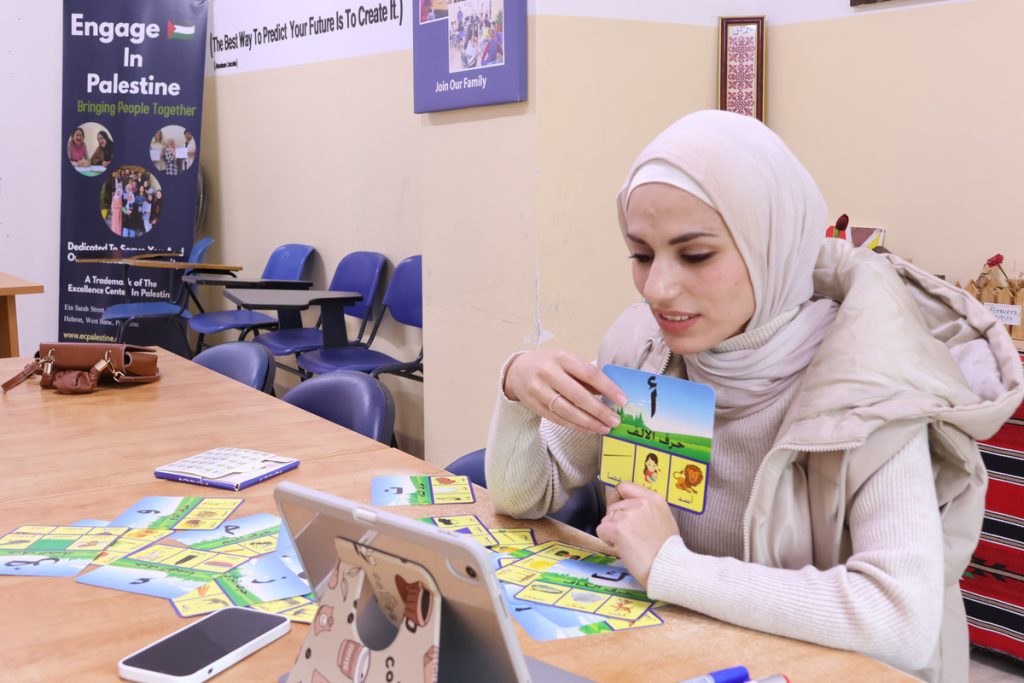
Palestinian Online Course: The Palestinian dialect, a colloquial form of Arabic known as Ammiya, belongs to the Southern Levantine dialect group and is widely spoken across Palestine. Notably, this dialect closely resembles Modern Standard Arabic, or Fusha, making it a practical choice for learners seeking to improve conversational skills and formal Arabic comprehension.
Additional Tips on Improving Palestinian Arabic
A well-rounded approach to learning Palestinian Arabic combines listening, speaking, reading, and cultural immersion. Consider the following strategies:
- Watch Palestinian TV shows and films with subtitles to familiarize yourself with pronunciation and expressions.
- Use audio-based language apps or YouTube channels dedicated to Palestinian Arabic.
- Engage in language exchange with native speakers via platforms like Tandem or HelloTalk.
- Take live classes (online or in-person) to get personalized instruction and practice speaking.
- Supplement with grammar books or phrasebooks focused on Palestinian Arabic.
Top Places to Study Palestinian Arabic for In-Person Lessons
If you want to deepen your understanding of Palestinian Arabic, several excellent programs and institutions offer immersive and accessible learning experiences. From intensive in-person courses to flexible online platforms, these options cater to learners of all levels and provide valuable cultural insights alongside language instruction:
1. The Excellence Center in Palestine
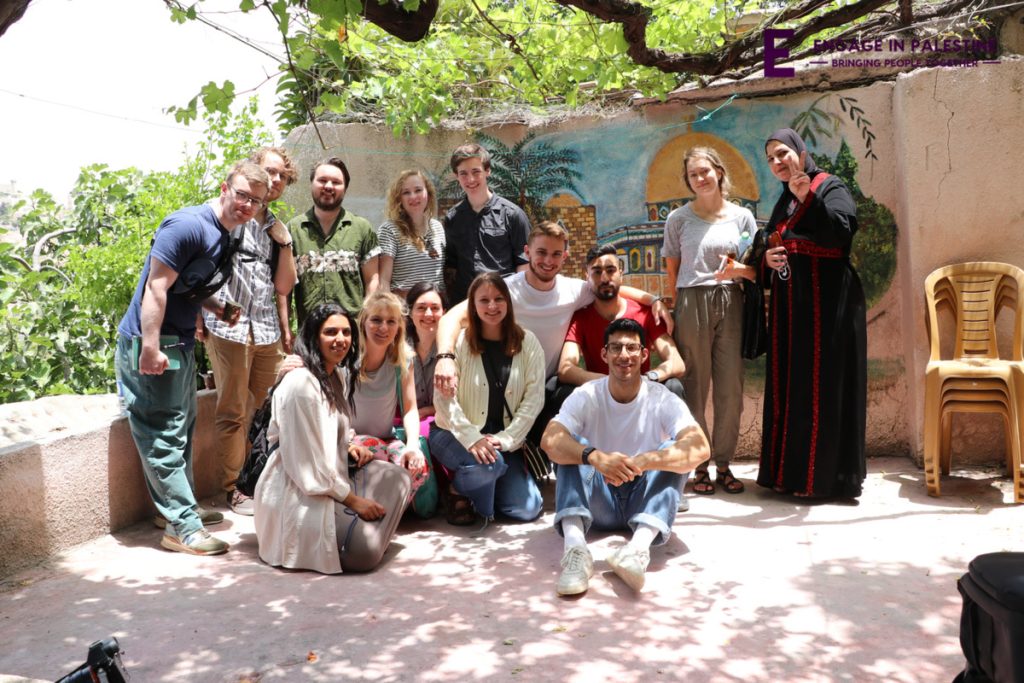
Study Palestinian Arabic: Enroll in our top-tier language program and study Palestinian Arabic at the Excellence Center! We are well known as one of Palestine’s best Arabic language schools. Our strategic location in Hebron (an affordable and bustling city in the West Bank) creates an ideal atmosphere to learn the Ammiya Arabic dialect (This dialect is spoken throughout Syria, Lebanon, Palestine, and Jordan).
2. The Excellence Center in Europe
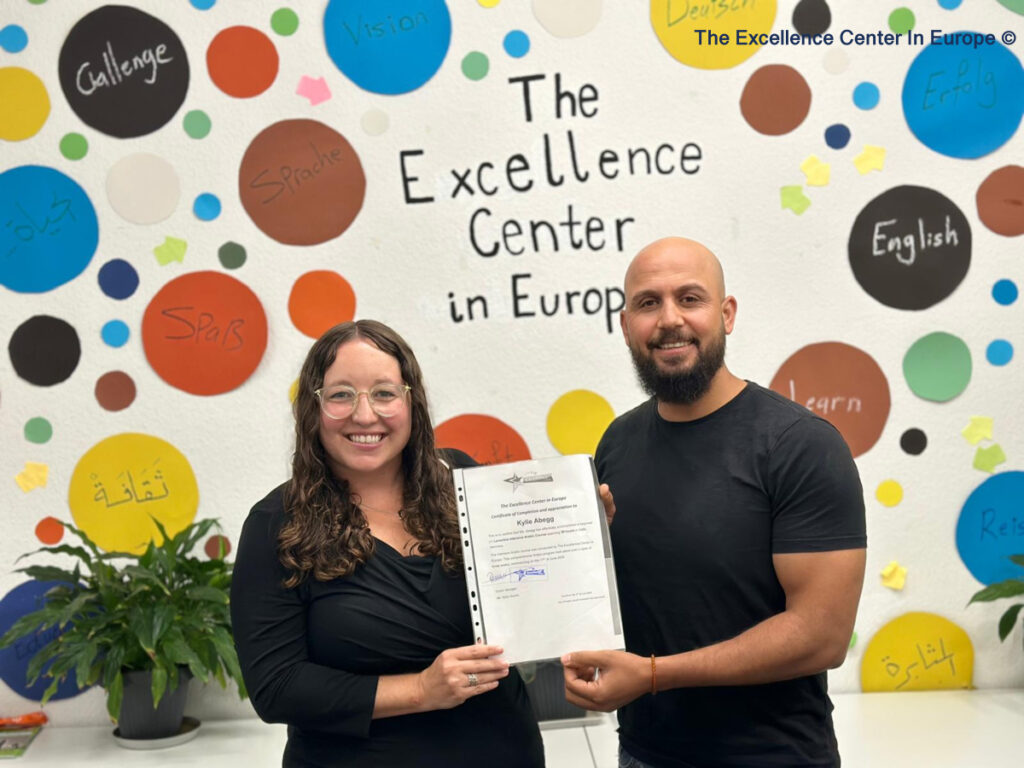
Study Palestinian Arabic in Germany: Students can explore the language and culture of a diverse Arabic diaspora by choosing to study Palestinian Arabic at the Excellence Center in Halle, Germany. The Excellence Center is a unique place where the German and Arabic languages and cultures converge. Many refugees, migrants, and asylum seekers live in Halle, creating a blend of cultures that demonstrates the utility of the Arabic language outside of the Middle East and North Africa.
3. Engage in Palestine
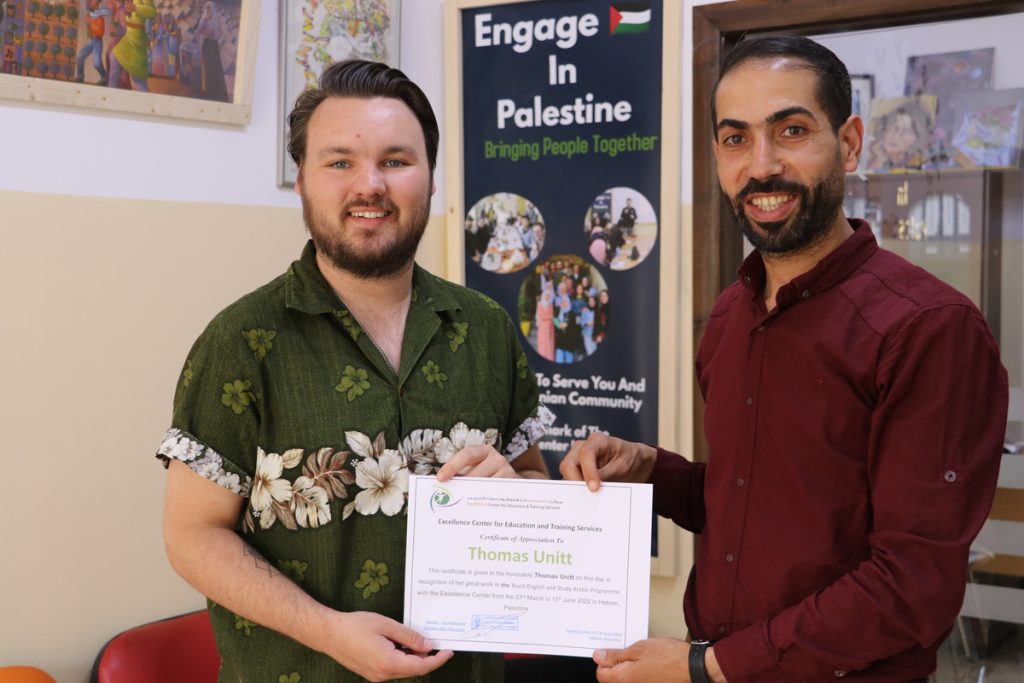
The Intensive Palestinian Arabic Program, by Engage in Palestine, is an excellent opportunity for those wishing to learn the colloquial Palestinian dialect of Arabic, connect with the wider Palestinian diaspora, and immerse themselves in the diverse culture of Palestine and the greater Levant. Engage in the West Bank offers courses at four levels and three intensities, depending on your needs.
4. Study in Palestine
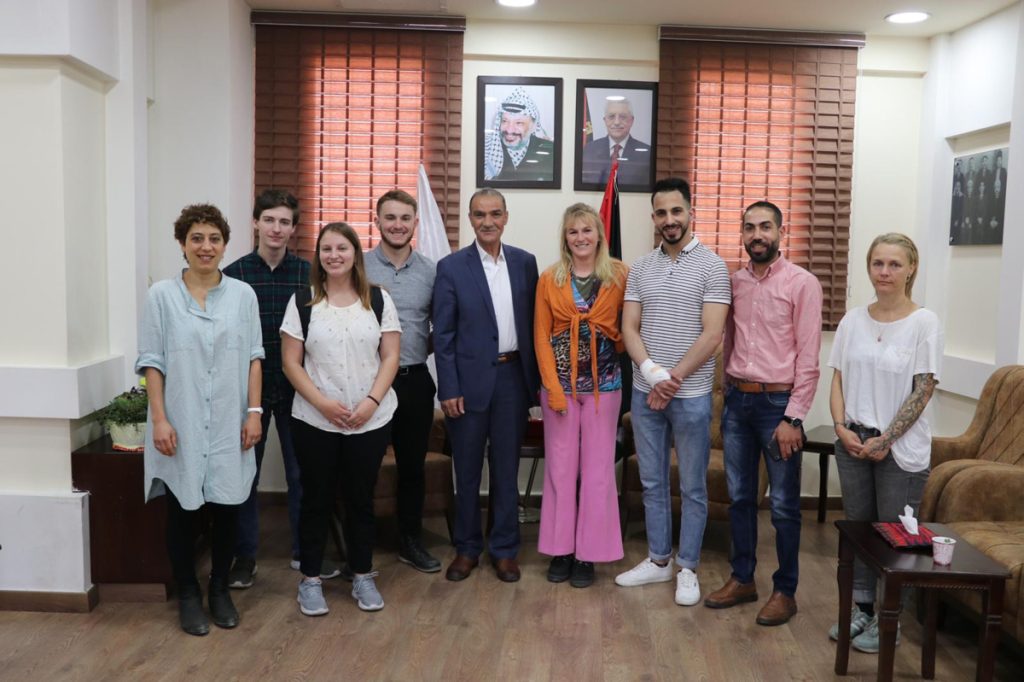
Join the premier Study in Palestine‘s language program to study Palestinian Arabic at a top school in the bustling city of Hebron. Experience the ideal atmosphere for learning the Levantine dialect spoken in Syria, Lebanon, Palestine, and Jordan. Immerse yourself in the rich culture of Palestine and the Levant, and gain insight into the region’s history and current events while building meaningful relationships with the Palestinian community.
What are Some Common Palestinian Arabic Expressions?
| English | Transliteration | Arabic |
|---|---|---|
| Good morning | ṣabāḥ il-khēr | صباح الخير |
| Good evening | masā’ il-khēr | مساء الخير |
| How are you? (spoken to male) | kīf ḥālak? | كيف حالك؟ |
| How are you? (spoken to female) | kīf ḥālik? | كيف حالِك؟ |
| How are you? (spoken to group) | kīf ḥālku? | كيف حالكو؟ |
| Fine (male) | mniḥ | منيح |
| Fine (female) | mniḥa | منيحة |
| Fine (group) | mniḥīn | منيحين |
| Thank you | šukran | شكراً |
| You’re welcome | ʿafwan | عفواً |
| Yes | āh | آه |
| No | lā | لا |
| God willing | in shā’ Allāh | إن شاء الله |
| Praise to God | il-ḥamdu lillāh | الحمد لله |
| What’s your name? (male) | šū ismak? | شو اسمك؟ |
| What’s your name? (female) | šū ismik? | شو اسمِك؟ |
Conclusion
Palestinian Arabic is a vibrant spoken dialect and a profound expression of Palestinian identity, history, and resilience. Its distinct sounds, vocabulary, and grammatical features set it apart from Modern Standard Arabic, while its roots in Levantine Arabic make it mutually intelligible with neighboring dialects. Despite the growing influence of formal Arabic in education and media, Palestinian Arabic continues to thrive in everyday life, serving as a vital bridge between generations and communities.
For learners, engaging with this dialect opens the door to deeper cultural understanding and more authentic communication with Palestinians both at home and in the diaspora. Whether through formal courses, media exposure, or language exchange, studying Palestinian Arabic offers linguistic skills and a meaningful connection to a rich and enduring cultural heritage.
